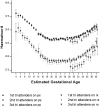Evaluation of a treatment protocol for anaemia in pregnancy nested in routine antenatal care in a limited-resource setting
- PMID: 31203791
- PMCID: PMC6586122
- DOI: 10.1080/16549716.2019.1621589
Evaluation of a treatment protocol for anaemia in pregnancy nested in routine antenatal care in a limited-resource setting
Abstract
Background: Anaemia in pregnancy is typically due to iron deficiency (IDA) but remains a complex and pervasive problem, particularly in low resource settings. At clinics on the Myanmar-Thailand border, a protocol was developed to guide treatment by health workers in antenatal care (ANC). Objective: To evaluate the clinical use of a protocol to treat anaemia in pregnancy. Methods: The design was a descriptive retrospective analysis of antenatal data obtained during the use of a standard anaemia treatment protocol. Two consecutive haematocrits (HCT) <30% prompted a change from routine prophylaxis to treatment doses of haematinics. Endpoints were anaemia at delivery (most recent HCT before delivery <30%) and timeliness of treatment initiation. Women whose HCT failed to respond to the treatment were investigated. Results: From August 2007 to July 2012, a median [IQR] of five [4-11] HCT measurements per woman resulted in the treatment of anaemia in 20.7% (2,246/10,886) of pregnancies. Anaemia at delivery was present in 22.8% (511/2,246) of treated women and 1.4% (123/8,640) who remained on prophylaxis. Human error resulted in a failure to start treatment in 97 anaemic women (4.1%, denominator 2,343 (2,246 + 97)). Fluctuation of HCT around the cut-point of 30% was the major problem with the protocol accounting for half of the cases where treatment was delayed greater than 4 weeks. Delay in treatment was associated with a 1.5 fold higher odds of anaemia at delivery (95% CI 1.18, 1.97). Conclusion: There was high compliance to the protocol by the health workers. An important outcome of this evaluation was that the clinical definition of anaemia was changed to diminish missed opportunities for initiating treatment. Reduction of anaemia in pregnancy requires early ANC attendance, prompt treatment at the first HCT <30%, and support for health workers.
Keywords: Anaemia; G6PD deficiency; Myanmar; haemoglobinopathy; health worker; iron deficiency; malaria; medical error; prophylaxis; protocol.
Figures


Similar articles
-
Detection & management of anaemia in pregnancy in an urban primary health care institution.Indian J Med Res. 2008 Jul;128(1):45-51. Indian J Med Res. 2008. PMID: 18820358
-
Anaemia in pregnancy and associated factors: a cross sectional study of antenatal attendants at the Sunyani Municipal Hospital, Ghana.BMC Res Notes. 2017 Aug 11;10(1):402. doi: 10.1186/s13104-017-2742-2. BMC Res Notes. 2017. PMID: 28800737 Free PMC article.
-
Descriptive epidemiology of anaemia among pregnant women initiating antenatal care in rural Northern Ghana.Afr J Prim Health Care Fam Med. 2019 Apr 10;11(1):e1-e7. doi: 10.4102/phcfm.v11i1.1892. Afr J Prim Health Care Fam Med. 2019. PMID: 31038334 Free PMC article.
-
Prepartum anaemia: prevention and treatment.Ann Hematol. 2008 Dec;87(12):949-59. doi: 10.1007/s00277-008-0518-4. Epub 2008 Jul 19. Ann Hematol. 2008. PMID: 18641987 Review.
-
[Review by expert group in the diagnosis and treatment of anemia in pregnant women. Federación Mexicana de Colegios de Obstetricia y Ginecología].Ginecol Obstet Mex. 2012 Sep;80(9):563-80. Ginecol Obstet Mex. 2012. PMID: 23243836 Spanish.
Cited by
-
Cohort profile: molecular signature in pregnancy (MSP): longitudinal high-frequency sampling to characterise cross-omic trajectories in pregnancy in a resource-constrained setting.BMJ Open. 2020 Oct 10;10(10):e041631. doi: 10.1136/bmjopen-2020-041631. BMJ Open. 2020. PMID: 33040018 Free PMC article. Clinical Trial.
-
Burden of soil-transmitted helminth infection in pregnant refugees and migrants on the Thailand-Myanmar border: Results from a retrospective cohort.PLoS Negl Trop Dis. 2021 Mar 1;15(3):e0009219. doi: 10.1371/journal.pntd.0009219. eCollection 2021 Mar. PLoS Negl Trop Dis. 2021. PMID: 33647061 Free PMC article.
-
Using an experience-based co-design approach to develop strategies for implementing an intravenous iron intervention to treat moderate and severe anemia in pregnancy in Malawi.Implement Sci Commun. 2024 Nov 15;5(1):129. doi: 10.1186/s43058-024-00661-1. Implement Sci Commun. 2024. PMID: 39548595 Free PMC article.
-
Integrating Women and Girls' Nutrition Services into Health Systems in Low- and Middle-Income Countries: A Systematic Review.Nutrients. 2022 Oct 25;14(21):4488. doi: 10.3390/nu14214488. Nutrients. 2022. PMID: 36364750 Free PMC article.
-
Perceptions and experiences of intravenous iron treatment for anaemia in pregnancy in Malawi: a formative qualitative study.Gates Open Res. 2024 Mar 8;6:66. doi: 10.12688/gatesopenres.13631.4. eCollection 2022. Gates Open Res. 2024. PMID: 38455670 Free PMC article.
References
-
- The World Health Organization The global prevalence of anaemia in 2011. Geneva: The World Health Organization; 2015.
-
- Filippi V, Chou D, Ronsmans C, et al. Levels and causes of maternal mortality and morbidity In: Black RE, Laxminarayan R, Temmerman M, et al, editors. Reproductive, maternal, newborn, and child health: disease control priorities. 3rd ed. Vol. 2 Washington (DC): The International Bank for Reconstruction and Development/The World Bank; 2016:51–70.
-
- Khan KS, Wojdyla D, Say L, et al. WHO analysis of causes of maternal death: a systematic review. Lancet. 2006;367:1066–8. - PubMed
-
- Bhutta ZA, Imdad A, Ramakrishnan U, et al. Is it time to replace iron folate supplements in pregnancy with multiple micronutrients? Paediatr Perinat Epidemiol. 2012;26 Suppl 1:27–35. - PubMed
-
- The World Health Organization WHO recommendations on antenatal care for a positive pregnancy experience. Geneva: World Health Organization; 2016. p. 152. - PubMed
Publication types
MeSH terms
Grants and funding
LinkOut - more resources
Full Text Sources
Medical
Molecular Biology Databases
Miscellaneous
